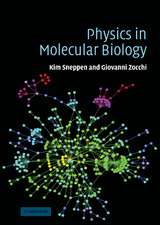Self-Organizing Maps: Springer Series in Information Sciences, cartea 30
Autor Teuvo Kohonenen Limba Engleză Paperback – 16 noi 2000
Din seria Springer Series in Information Sciences
- 20%
 Preț: 337.66 lei
Preț: 337.66 lei - 18%
 Preț: 955.08 lei
Preț: 955.08 lei - 15%
 Preț: 646.62 lei
Preț: 646.62 lei - 20%
 Preț: 337.52 lei
Preț: 337.52 lei -
 Preț: 385.62 lei
Preț: 385.62 lei -
 Preț: 381.98 lei
Preț: 381.98 lei -
 Preț: 391.61 lei
Preț: 391.61 lei - 20%
 Preț: 324.64 lei
Preț: 324.64 lei -
 Preț: 380.84 lei
Preț: 380.84 lei - 18%
 Preț: 777.69 lei
Preț: 777.69 lei -
 Preț: 387.96 lei
Preț: 387.96 lei -
 Preț: 396.62 lei
Preț: 396.62 lei - 20%
 Preț: 330.75 lei
Preț: 330.75 lei -
 Preț: 382.57 lei
Preț: 382.57 lei - 15%
 Preț: 642.18 lei
Preț: 642.18 lei - 15%
 Preț: 640.06 lei
Preț: 640.06 lei -
 Preț: 387.58 lei
Preț: 387.58 lei - 20%
 Preț: 333.40 lei
Preț: 333.40 lei -
 Preț: 386.99 lei
Preț: 386.99 lei - 20%
 Preț: 653.71 lei
Preț: 653.71 lei - 15%
 Preț: 661.02 lei
Preț: 661.02 lei - 15%
 Preț: 638.43 lei
Preț: 638.43 lei - 15%
 Preț: 642.68 lei
Preț: 642.68 lei -
 Preț: 386.00 lei
Preț: 386.00 lei - 20%
 Preț: 649.60 lei
Preț: 649.60 lei - 18%
 Preț: 950.21 lei
Preț: 950.21 lei -
 Preț: 393.35 lei
Preț: 393.35 lei - 20%
 Preț: 652.41 lei
Preț: 652.41 lei - 20%
 Preț: 645.65 lei
Preț: 645.65 lei -
 Preț: 390.25 lei
Preț: 390.25 lei -
 Preț: 387.96 lei
Preț: 387.96 lei - 15%
 Preț: 580.97 lei
Preț: 580.97 lei
Preț: 1391.21 lei
Preț vechi: 1696.59 lei
-18% Nou
Puncte Express: 2087
Preț estimativ în valută:
266.22€ • 284.67$ • 221.96£
266.22€ • 284.67$ • 221.96£
Carte tipărită la comandă
Livrare economică 17 aprilie-01 mai
Preluare comenzi: 021 569.72.76
Specificații
ISBN-13: 9783540679219
ISBN-10: 3540679219
Pagini: 532
Ilustrații: XX, 502 p. 178 illus., 1 illus. in color.
Dimensiuni: 155 x 235 x 28 mm
Greutate: 0.74 kg
Ediția:3rd ed. 2001
Editura: Springer Berlin, Heidelberg
Colecția Springer
Seria Springer Series in Information Sciences
Locul publicării:Berlin, Heidelberg, Germany
ISBN-10: 3540679219
Pagini: 532
Ilustrații: XX, 502 p. 178 illus., 1 illus. in color.
Dimensiuni: 155 x 235 x 28 mm
Greutate: 0.74 kg
Ediția:3rd ed. 2001
Editura: Springer Berlin, Heidelberg
Colecția Springer
Seria Springer Series in Information Sciences
Locul publicării:Berlin, Heidelberg, Germany
Public țintă
ResearchCuprins
1. Mathematical Preliminaries.- 2. Neural Modeling.- 3. The Basic SOM.- 4. Physiological Interpretation of SOM.- 5. Variants of SOM.- 6. Learning Vector Quantization.- 7. Applications.- 8. Software Tools for SOM.- 9. Hardware for SOM.- 10. An Overview of SOM Literature.- 11. Glossary of “Neural” Terms.- References.
Textul de pe ultima copertă
The Self-Organizing Map (SOM), with its variants, is the most popular artificial neural network algorithm in the unsupervised learning category. About 4000 research articles on it have appeared in the open literature, and many industrial projects use the SOM as a tool for solving hard real-world problems. Many fields of science have adopted the SOM as a standard analytical tool: in statistics, signal processing, control theory, financial analyses, experimental physics, chemistry and medicine. The SOM solves difficult high-dimensional and nonlinear problems such as feature extraction and classification of images and acoustic patterns, adaptive control of robots, and equalization, demodulation, and error-tolerant transmission of signals in telecommunications. A new area is organization of very large document collections. Last but not least, it may be mentioned that the SOM is one of the most realistic models of the biological brain function. This new edition includes a survey of over 2000 contemporary studies to cover the newest results; case examples were provided with detailed formulae, illustrations, and tables; a new chapter on Software Tools for SOM was written, other chapters were extended or reorganized.
Caracteristici
Best-selling key reference Completely revised and brought up-to-date Includes supplementary material: sn.pub/extras
















